Philippine cuisine

| Part of a series on the |
| Culture of the Philippines |
|---|
 |
| History |
| People |
| Languages |
| Traditions |
| Cuisine |
| Festivals |
| Religion |
| Art |
| Literature |
|
Music and performing arts |
|
Monuments |
|
Philippine cuisine (Filipino: Lutuing Pilipino or Pagkaing Pilipino) consists of the food, preparation methods, and eating customs found in the Philippines. The style of cooking and the food associated with it have evolved over many centuries from their Austronesian origins to a mixed cuisine of Malay-Indonesian, Indian, Japanese, Chinese, Spanish, and American, in line with the major waves of influence that had enriched the cultures of the archipelago, as well as others adapted to indigenous ingredients and the local palate.[1]
Dishes range from the very simple, like a meal of fried salted fish and rice, to the elaborate paellas and cocidos created for fiestas of Spanish origin. Popular dishes include: lechón[2] (whole roasted pig), longganisa (Philippine sausage), tapa (cured beef), torta (omelette), adobo (chicken and/or pork braised in garlic, vinegar, oil and soy sauce, or cooked until dry), kaldereta (meat in tomato sauce stew), mechado (larded beef in soy and tomato sauce), puchero (beef in bananas and tomato sauce), afritada (chicken and/or pork simmered in tomato sauce with vegetables), kare-kare (oxtail and vegetables cooked in peanut sauce), pinakbet (kabocha squash, eggplant, beans, okra, and tomato stew flavored with shrimp paste), crispy pata (deep-fried pig's leg), hamonado (pork sweetened in pineapple sauce), sinigang (meat or seafood in sour broth), pancit (noodles), and lumpia (fresh or fried spring rolls).
History and influences
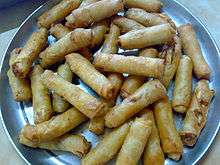
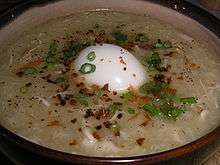
During the pre-Hispanic era in the Philippines, the preferred Austronesian methods for food preparation were boiling, steaming and roasting. The ingredients for common dishes were obtained from locally raised livestock. These ranged from kalabaw (water buffaloes/carabaos), baka (cows), manok (chickens) and baboy (pigs) to various kinds of fish and seafood. In 3200 BCE, Austronesians from the southern China (Yunnan-Guizhou Plateau) and Taiwan settled in the region that is now called the Philippines. They brought with them knowledge of rice cultivation and other farming practices which increased the number and variety of edible dish ingredients available for cooking.[3]
Direct trade and cultural exchange with Hokkien China in the Philippines in the Song dynasty (960–1279 AD) with porcelain, ceramics, and silk being traded for spices and trepang in Luzon.[4] This early cultural contact with China introduced a number of staple food into Philippine cuisine, most notably toyo (soy sauce; Chinese: 豆油; Pe̍h-ōe-jī: tāu-yu), tokwa; (tofu; Chinese: 豆干; Pe̍h-ōe-jī: tāu-koaⁿ), toge (bean sprout; Chinese: 豆芽; Pe̍h-ōe-jī: tāu-koaⁿ), and patis (fish sauce), as well as the method of stir frying and making savory soup bases. Many of these food items and dishes retained their original Hokkien names, such as pancit (Chinese: 便ê食; Pe̍h-ōe-jī: piān-ê-si̍t)(Chinese: 扁食; pinyin: biǎn shí), and lumpia (Chinese: 潤餅; Pe̍h-ōe-jī: jūn-piáⁿ, lūn-piáⁿ).[4] The Chinese food introduced during this period were food of the workers and traders, which became a staple of the noodle shops (panciterias), and can be seen in dishes like arroz caldo (congee), sinangag (fried rice), chopsuey.
Trade with the various neighboring kingdoms of Malacca and Srivijaya in Malaya and Java brought with it foods and cooking methods which are still commonly used in the Philippines today, such as Bagoong (Malay: Belacan), Patis, Puso (Malay: Ketupat), Rendang, Kare-kare and the infusion of coconut milk in condiments, such as laing and Ginataang Manok (chicken stewed in coconut milk). Through the trade with the Malay-Indonesian kingdoms, cuisine from as far away as India and Arabia enriched the palettes of the local Austronesians (particularly in the areas of southern Luzon, Mindanao, Sulu, Palawan, the Visayas and Bicol, where trade was strongest). These foods include various dishes eaten in areas of the southern part of the archipelago today, such as puto derived from Indian cuisine puttu, kurmah, satti and biryani.
Spanish colonizers and friars in the 16th century brought with them produce from the Americas like chili peppers, tomatoes, corn, potatoes, and the method of sautéing with garlic and onions. Chili leaves are frequently used as a cooking green. Spanish (and Mexican) dishes were eventually incorporated into Philippine cuisine with the more complex dishes usually being prepared for special occasions. Some dishes such as arroz a la valenciana remain largely the same in the Philippine context. Some have been adapted or have come to take on a slightly or significantly different meaning. Arroz a la cubana served in the Philippines usually includes ground beef picadillo. Philippine longganisa despite its name is more akin to chorizo than Spanish longaniza (in Visayan regions, it is still known as chorizo). Morcon is likely to refer to a beef roulade dish not the bulbous specialty Spanish sausage.
Today, Philippine cuisine continues to evolve as new techniques, styles of cooking, and ingredients find their way into the country. Traditional dishes both simple and elaborate, indigenous and foreign-influenced, are seen as are more current popular international viands and fast food fare. However, the Filipino diet is higher in total fat, saturated fat, and cholesterol than other Asian diets.[5]
Characteristics

Filipino cuisine centres around the combination of sweet (tamis), sour (asim), and salty (alat),[2] although in Bicol, the Cordilleras and among Muslim Filipinos, spicy (anghang) is a base of cooking flavor.
Counterpoint is a feature in Philippine cuisine which normally comes in a pairing of something sweet with something salty, and results in surprisingly pleasing combinations. Examples include: champorado (a sweet cocoa rice porridge), being paired with tuyo (salted, sun-dried fish); dinuguan (a savory stew made of pig's blood and innards), paired with puto (sweet, steamed rice cakes); unripe fruits such as mangoes (which are only slightly sweet but very sour), are eaten dipped in salt or bagoong; the use of cheese (which is salty) in sweetcakes (such as bibingka and puto), as well as an ice cream flavoring.
Vinegar is a common ingredient. Adobo is popular[2] not solely for its simplicity and ease of preparation, but also for its ability to be stored for days without spoiling, and even improve in flavor with a day or two of storage. Tinapa is a smoke-cured fish while tuyo, daing, and dangit are corned, sun-dried fish popular because they can last for weeks without spoiling, even without refrigeration.
Cooking and eating in the Philippines has traditionally been an informal and communal affair centered around the family kitchen. Filipinos traditionally eat three main meals a day: agahan or almusal (breakfast), tanghalían (lunch), and hapunan (dinner) plus an afternoon snack called meriénda (also called minandál or minindál). Snacking is normal. Dinner, while still the main meal, is smaller than other countries. Usually, either breakfast or lunch is the largest meal. Food tends to be served all at once and not in courses. Unlike many of their Asian counterparts Filipinos do not eat with chopsticks. Due to Western influence, food is often eaten using flatware—forks, knives, spoons—but the primary pairing of utensils used at a Filipino dining table is that of spoon and fork, not knife and fork. The traditional way of eating is with the hands, especially dry dishes such as inihaw or prito. The diner will take a bite of the main dish, then eat rice pressed together with his fingers. This practice, known as kamayan, is rarely seen in urbanized areas. However, Filipinos tend to feel the spirit of kamayan when eating amidst nature during out-of-town trips, beach vacations, and town fiestas.[6]
Common dishes
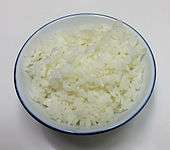
As with most Asian countries, the staple food in the Philippines is rice.[7] It is most often steamed and always served with meat, fish and vegetable dishes. Leftover rice is often fried with garlic to make sinangag, which is usually served at breakfast together with a fried egg and cured meat or sausages. Rice is often enjoyed with the sauce or broth from the main dishes. In some regions, rice is mixed with salt, condensed milk, cocoa, or coffee. Rice flour is used in making sweets, cakes and other pastries. Sticky rice with cocoa, also called champorado is also a common dish served with tuyo or dried herring.
A variety of fruits and vegetables are often used in cooking. Bananas (the saba variety in particular), kalamansi, guavas (bayabas), mangoes, papayas, and pineapples lend a distinctly tropical flair in many dishes, but mainstay green leafy vegetables like water spinach (kangkong), Chinese cabbage (petsay), Napa cabbage (petsay wombok), cabbage (repolyo) and other vegetables like eggplants (talong) and yard-long beans (sitaw) are just as commonly used. Coconuts are ubiquitous. Coconut meat is often used in desserts, coconut milk (kakang gata) in sauces, and coconut oil for frying. Abundant harvests of root crops like potatoes, carrots, taro (gabi), cassava (kamoteng kahoy), purple yam (ube), and sweet potato (kamote) make them readily available. The combination of tomatoes (kamatis), garlic (bawang), and onions (sibuyas) is found in many dishes.
Meat staples include chicken, pork, beef, and fish. Seafood is popular as a result of the bodies of water surrounding the archipelago. Popular catches include tilapia, catfish (hito), milkfish (bangus), grouper (lapu-lapu), shrimp (hipon), prawns (sugpo), mackerel (galunggong, hasa-hasa), swordfish (isdang-ispada), oysters (talaba), mussels (tahong), clams (halaan and tulya), large and small crabs (alimango and alimasag respectively), game fish, sablefish, tuna, cod (bakalaw), blue marlin, and squid/cuttlefish (both called pusit). Also popular are seaweeds (damong dagat), abalone, and eel (igat).
The most common way of having fish is to have it salted, pan-fried or deep-fried, and then eaten as a simple meal with rice and vegetables. It may also be cooked in a sour broth of tomatoes or tamarind as in pangat, prepared with vegetables and a souring agent to make sinigang, simmered in vinegar and peppers to make paksiw, or roasted over hot charcoal or wood (inihaw). Other preparations include escabeche (sweet and sour), relleno (deboned and stuffed), or "kinilaw" (similar to ceviche; marinated in vinegar or kalamansi). Fish can be preserved by being smoked (tinapa) or sun-dried (tuyo or daing).
Food is often served with various dipping sauces. Fried food is often dipped in vinegar, soy sauce, juice squeezed from Kalamansi (Philippine lime or calamansi), or a combination of two or all. Patis (fish sauce) may be mixed with kalamansi as dipping sauce for most seafood. Fish sauce, fish paste (bagoong), shrimp paste (bagoong alamang) and crushed ginger root (luya) are condiments that are often added to dishes during the cooking process or when served.
Breakfast
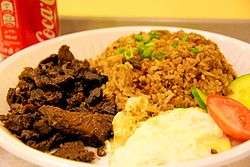
A traditional Filipino breakfast might include pandesal (small bread rolls), kesong puti (white cheese), champorado (chocolate rice porridge), sinangag (garlic fried rice), and meat—such as tapa, longganisa, tocino, karne norte (corned beef), or fish such as daing na bangus (salted and dried milkfish)—or itlog na pula (salted duck eggs). Coffee is also commonly served particularly kapeng barako, a variety of coffee produced in the mountains of Batangas noted for having a strong flavor.
Certain portmanteaus in Filipino have come into use to describe popular combinations of items in a Filipino breakfast. An example of such a combination order is kankamtuy: an order of kanin (rice), kamatis (tomatoes) and tuyo (dried fish). Another is tapsi: an order of tapa and sinangág. Other examples include variations using a silog suffix, usually some kind of meat served with sinangág and itlog (egg). The three most commonly seen silogs are tapsilog (having tapa as the meat portion), tocilog (having tocino as the meat portion), and longsilog (having longganisa as the meat portion). Other silogs include hotsilog (with a hot dog), bangsilog (with bangus (milkfish)), dangsilog (with danggit (rabbitfish)), spamsilog (with spam), adosilog (with adobo), chosilog (with chorizo), chiksilog (with chicken), cornsilog (with corned beef), and litsilog (with lechon/litson). Pankaplog is a slang term referring to a breakfast consisting of pandesal, kape (coffee), and itlog (egg).[8] An establishment that specializes in such meals is called a tapsihan or tapsilugan.
Merienda
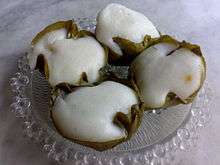
Merienda is taken from the Spanish, and is a light meal or snack especially in the afternoon, similar to the concept of afternoon tea.[9] If the meal is taken close to dinner, it is called merienda cena, and may be served instead of dinner.[10]
Filipinos have a number of options to take with kapé, which is the Filipino pronunciation of café (coffee): breads and pastries like pandesal, ensaymada (buttery brioche covered in grated cheese and sugar), hopia (pastries similar to mooncakes filled with mung bean paste) and empanada (savoury, meat-filled pasties). Also popular are kakanín, or traditional pastries made from sticky rice like kutsinta, sapin-sapin (multicoloured, layered pastry), palitaw, biko, suman, Bibingka, and pitsi-pitsî (served with desiccated coconut).
Savoury dishes often eaten during merienda include pancit canton (stir-fried noodles), palabok (rice noodles with a shrimp-based sauce), tokwa't baboy (fried tofu with boiled pork ears in a garlic-flavoured soy sauce and vinegar dressing), and dinuguan (a spicy stew made of pork blood), which is often served with puto (steamed rice flour cakes).
Dim sum and dumplings, brought to the islands by Fujianese migrants, have been given a Filipino touch and are also popular merienda fare. Street food, such as squid balls and fish balls, are often skewered on bamboo sticks and consumed with soy sauce and the sour juice of the calamondin as condiments.
Pulutan
Pulutan[11] (from the Filipino word pulutin which literally means "to pick something up") is a term roughly analogous to the English term "finger food" or Spanish Tapas. Originally, it was a snack accompanied with liquor or beer but has found its way into Philippine cuisine as appetizers or, in some cases, main dishes, as in the case of sisig.
Deep fried pulutan include chicharrón (also spelled chicharon or tsitsaron), pork rinds that have been boiled and then twice fried, the second frying gives the crunchiness and golden color; chicharong bituka, pig intestines that have been deep fried to a crisp; chicharong bulaklak, similar to chicharong bituka it is made from mesenteries of pig intestines and has a bulaklak or flower appearance; and chicharong manok, chicken skin that has been deep fried until crisp.
Examples of grilled foods include: isaw, or chicken or pig intestines skewered and then grilled; Inihaw na tenga, pig ears that have been skewered and then grilled; pork barbecue, skewered pork marinated in a sweet soy-garlic blend and then grilled; betamax, salted solidified pork or chicken blood which is then skewered and lightly grilled; adidas which is grilled or sautéed chicken feet. There is also sisig, a popular pulutan made from the pig's cheek skin, ears and liver that is initially boiled, then charcoal grilled and afterwards minced and cooked with chopped onions, chillies, and spices.
Smaller snacks such as mani (peanuts) are often sold steamed in the shell, salted, spiced or flavored with garlic by street vendors in the Philippines. Another snack is kropeck, which is fish crackers.
Tokwa't baboy is fried tofu with boiled pork marinated in a garlic-flavored soy sauce or vinegar dip. It is also served as a side dish to pancit luglog or pancit palabok.
You can also find tuhog-tuhog accompanied by sweet or spicy sauce. This include Fish balls, Kikiam, Squid balls etc., these are commonly served during a small gathering or in local bars.
Bread and pastries

.jpg)
In a typical Filipino bakery, pandesal, monay and ensaymada are often sold. Pandesal comes from the Spanish pan de sal (literally, bread of salt), and is a ubiquitous breakfast fare, normally eaten with (and sometimes even dipped in) coffee. It typically takes the form of a bread roll, and is usually baked covered in bread crumbs. Contrary to what its name implies, pandesal is not particularly salty as very little salt is used in baking it. Monay is a firmer slightly denser heavier bread. Ensaymada, from the Spanish ensaimada, is a pastry made using butter and often topped with sugar and shredded cheese that is especially popular during Christmas. It is sometimes made with fillings such as ube (purple yam) and macapuno (a variety of coconut the meat of which is often cut into strings, sweetened, preserved, and served in desserts). Also commonly sold in Filipino bakeries is pan de coco, a sweet roll filled with shredded coconut mixed with molasses. Putok, which literally means "explode", refers to a small, hard bread roll whose cratered surface is glazed with sugar. Kababayan is a small, sweet gong-shaped muffin that has a moist consistency. Spanish bread refers to a rolled pastry which looks like a croissant prior to being given a crescent shape, and has a filling consisting of sugar and butter.
There are also rolls like pianono, which is a chiffon roll flavored with different fillings. Brazo de mercedes, a rolled cake or jelly roll, is made from a sheet of meringue rolled around a custard filling. Similar to the previous dessert, it takes on a layered presentation instead of being rolled and typically features caramelized sugar and nuts for sans rival. Silvañas are large, oval-shaped, cookie-sized desserts, with a thin meringue on either side of a buttercream filling and dusted with crumbed cookies. Not overly sweet, they are rich, crisp, chewy, and buttery all at the same time. Barquillos use sweet thin crunchy wafers rolled into tubes that can be sold hollow or filled with polvoron (sweetened and toasted flour mixed with ground nuts). Meringues are also present in the Philippines, due to the Spanish influence, but they are called merengue – with all the vowels pronounced. Leche flan is a type of caramel custard made with eggs and milk similar to the French creme caramel. Leche flan (the local term for the original Spanish flan de leche, literally "milk flan") is a heavier version of the Spanish flan made with condensed milk and more egg yolks. Leche flan is usually steamed over an open flame or stove top, although on rare occasions it can also be seen baked. Leche flan is a staple in celebratory feasts.
A heavier version of leche flan, tocino del cielo, is similar, but has significantly more egg yolks and sugar.
.jpg)
The egg pie with a very rich egg custard filling is a mainstay in local bakeries. It is typically baked so that the exposed custard on top is browned. Buko pie is made with a filling made from young coconut meat and dairy. Mini pastries like turrones de casuy are made up of cashew marzipan wrapped with a wafer made to resemble a candy wrapper but take on a miniature look of a pie in a size of about a quarter. There is also napoleones – again with all the vowels pronounced – a mille-feuille pastry stuffed with a sweet milk-based filling.
There are hard pastries like biskotso a crunchy, sweet, twice-baked bread. Another baked goody is sinipit which is a sweet pastry covered in a crunchy sugar glaze, made to resemble a length of rope. Similar to sinipit is a snack eaten on roadsides colloquially called shingaling. It is hollow but crunchy with a salty flavor.
For a softer treat there is mamon a chiffon-type cake sprinkled with sugar, its name derived from a slang Spanish term for breast. There's also crema de fruta, which is an elaborate sponge cake topped in succeeding layers of cream, custard, candied fruit, and gelatine. Similar to a sponge cake is mamoncillo which generally refers to slices taken from a large mamon cake, but it is unrelated to the fruit of the same name. Sandwich pastries like inipit are made with two thin layers of chiffon sandwiching a filling of custard that is topped with butter and sugar. Another mamon variant is mamon tostada, basically mamoncillo toasted to a crunchy texture.
Stuffed pastries that reflect both Western and Eastern influence are common. One can find empanadas, a turnover-type pastry filled with a savory-sweet meat filling. Typically filled with ground meat and raisins, it can be deep fried or baked. Siopao is the local version of Chinese baozi. Buchi is another snack that is likely of Chinese origin. Bite-sized, buchi is made of deep-fried dough balls (often from rice flour) filled with a sweet mung bean paste, and coated on the outside with sesame seeds; some variants also have ube as the filling. There are also many varieties of the mooncake-like hopia, which come in different shapes (from a flat, circular stuffed form, to cubes), and have different textures (predominantly using flaky pastry, but sometimes like the ones in mooncakes) and fillings.
Fiesta food
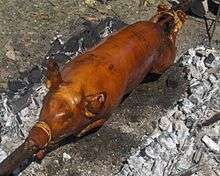
For festive occasions, people band together and prepare more sophisticated dishes. Tables are often laden with expensive and labor-intensive treats requiring hours of preparation. In Filipino celebrations, lechón (also spelled litson)[12] serves as the centerpiece of the dinner table. It is usually a whole roasted pig, but suckling pigs (lechonillo, or lechon de leche) or cattle calves (lechong baka) can also be prepared in place of the popular adult pig. It is typically served with lechon sauce, which is traditionally made from the roasted pig's liver. Other dishes include hamonado (honey-cured beef, pork or chicken), relleno (stuffed chicken or milkfish), mechado, afritada, caldereta, puchero, paella, menudo, morcon, embutido (referring to a meatloaf dish, not a sausage as understood elsewhere), suman (a savory rice and coconut milk concoction steamed in leaves such as banana), and pancit canton. The table may also be have various sweets and pastries such as leche flan, ube, sapin-sapin, sorbetes (ice creams), totong (a rice, coconut milk and mongo bean pudding), ginataan (a coconut milk pudding with various root vegetables and tapioca pearls), and gulaman (an agar jello-like ingredient or dessert).
Christmas Eve, known as Noche Buena, is the most important feast. During this evening, the star of the table is the Christmas ham and Edam cheese (queso de bola). Supermarkets are laden with these treats during the Christmas season and are popular giveaways by Filipino companies in addition to red wine, brandy, groceries, or pastries. Available mostly during the Christmas season and sold in front of churches along with bibingka, puto bumbong is a purple yam-flavored puto.
More common at celebrations than in everyday home meals, lumpiang sariwa, or fresh lumpia, is a fresh spring roll that consists of a soft crepe wrapped around a filling that can include strips of kamote (sweet potato), singkamas (jicama), bean sprouts, green beans, cabbage, carrots and meat (often pork). It can be served warm or cold and typically with a sweet peanut and garlic sauce. Ukoy is shredded papaya combined with small shrimp (and occasionally bean sprouts) and fried to make shrimp patties. It is often eaten with vinegar seasoned with garlic, salt and pepper. Both lumpiang sariwa and ukoy are often served together in Filipino parties. Lumpiang sariwa has Chinese origins, having been derived from popiah.[13]
Regional specialties
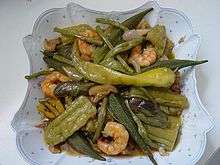

The Philippine islands are home to various ethnic groups resulting in varied regional cuisines.
Northern Philippine cuisine
Ilocanos, from the rugged Ilocos region, boast of a diet heavy in boiled or steamed vegetables and freshwater fish, but they are particularly fond of dishes flavored with bagoong, fermented fish that is often used instead of salt. Ilocanos often season boiled vegetables with bagoong monamon (fermented anchovy paste) to produce pinakbet. Local specialties include the soft white larvae of ants and "jumping salad" of tiny live shrimp.
The Igorots prefer roasted meats, particularly carabao meat, goat meat, and venison.
Due to its mild, sub-tropical climate, Baguio, along with the outlying mountainous regions, is renowned for its produce. Temperate-zone fruits and vegetables (strawberries being a notable example) which would otherwise wilt in lower regions are grown there. It is also known for a snack called sundot-kulangot which literally means "poke the booger." It's actually a sticky kind of sweet made from milled glutinous rice flour mixed with molasses, and served inside pitogo shells, and with a stick to "poke" its sticky substance with.
The town of Calasiao in Pangasinan is known for its puto, a type of steamed rice cake.
Kapampangan cuisine makes use of all the produce in the region available to the native cook. Among the treats produced in Pampanga are longganisa (original sweet and spicy sausages), calderetang kambing (savory goat stew), and tocino (sweetened cured pork). Combining pork cheeks and offal, Kapampangans make sisig.
Bulacan is popular for chicharon (pork rinds) and steamed rice and tuber cakes like puto. It is a center for panghimagas or desserts, like brown rice cake or kutsinta, sapin-sapin, suman, cassava cake, halaya ube and the king of sweets, in San Miguel, Bulacan, the famous carabao milk candy pastillas de leche, with its pabalat wrapper.[14]
Isabela is known for Pancit Cabagan of Cabagan, Inatata & Binallay of Ilagan City are rice cakes prepared year-round in the city and both famous delicacies specially during the lenten season. Cagayan for its famous Carabao Milk Candy in the town Alcala and Tuguegarao City for Pancit Batil Patung and Buko Roll.
Cainta, in Rizal province east of Manila, is known for its Filipino rice cakes and puddings. These are usually topped with latik, a mixture of coconut milk and brown sugar, reduced to a dry crumbly texture. A more modern, and time saving alternative to latik are coconut flakes toasted in a frying pan.
Antipolo City, straddled mid-level in the mountainous regions of the Philippine Sierra Madre, is a town known for its suman and cashew products.
Laguna is known for buko pie (coconut pie) and panutsa (peanut brittle).
Batangas is home to Taal Lake, a body of water that surrounds Taal Volcano. The lake is home to 75 species of freshwater fish. Among these, the maliputo and tawilis are two not commonly found elsewhere. These fish are delicious native delicacies. Batangas is also known for its special coffee, kapeng barako.
Central Philippine cuisine
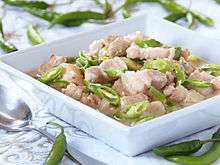
Bicol is noted for its gastronomic appetite for the fiery or chili-hot dishes.[15] Perhaps the most well-known Bicolano dish is the very spicy Bicol Express. The region is also the well-known home of natong also known as laing or pinangat (a pork or fish stew in taro leaves).
Bacolod City is the capital of Negros Occidental. Much of its cuisine is shared with Iloilo City, a neighboring city on the island of Panay. There are a plethora of restaurants in Bacolod that serve delicious local dishes which visitors shouldn’t miss when they travel in the city.[16] It is known for "inasal" which literally translates to “cooked over fire”. The "chicken inasal" is a local version of chicken barbecue. It is cooked with red achuete or annatto seeds giving it a reddish color, and brushed with oil and cooked over the fire. The city is also famous for various delicacies such as piaya, napoleones and pinasugbo (hard candied banana sprinkled with sesame seeds).
Aklan is synonymous with Inubarang Manok, chicken simmered in coconut milk, as well as Binakoe na Manok, chicken cooked in bamboo with lemongrass. Of particular interest is Tamilok (wood worms), which is either eaten raw or dipped in an acidic sauce such as vinegar or calamansi.[17][18] There is a special prevalence of chicken and coconut milk (gata) in Akeanon cooking.[19]
Iloilo is home of the Batchoy, derived from “Ba-chui” meaning pieces of meat in Chinese. The authentic Batchoy contains fresh egg noodles called miki, buto-buto broth slow-cooked for hours, and beef, pork and bulalo mixed with the local guinamos (shrimp paste). Toppings include generous amounts of fried garlic, crushed chicharon,scallions, slices of pork intestines and liver.[20] Another type of pancit which is found in the said province is Pancit molo, an adaptation of wonton soup and is a specialty of the town of Molo, a well-known district in Iloilo. Unlike other pancit, Pancit molo is not dry but soupy and it does not make use of long, thin noodles but instead wonton wrappers made from rice flour.[21] Iloilo, is also famous for its two kadios or pigeon pea-based soups. The first is KBL or "Kadios Baboy Langka". As the name implies, the three main ingredients of this dish are kadyos, baboy (pork), and langka (unripe jackfruit is used here).[22] Another one is KMU or "Kadios Manok Ubad". This dish is composed mainly of kadyos, manok (preferably free range chicken called Bisaya nga Manok in Iloilo), and ubad(thinly cut white core of the banana stalk/trunk).[23] Both of these dishes utilize another Ilonggo ingredient as a souring agent. This ingredient is batwan or Garcinia binucao, a fruit closely related to mangosteen, which is very popular in Western Visayas but is generally unknown to other parts of the Philippines.[24]
Roxas City is another food destination in Western Visayas aside from Iloilo and Bacolod Cities. This seaside city that's about two to three hours by bus from Iloilo City is the hailed as the Seafood Capital of the Philippines due to its bountiful rivers, estuaries and seas. Numerous seafood dishes are served in the city's Baybay area from mussels, oysters, scallops, prawns, seaweeds, clams, fish and many more.
Cebu is known for its lechón variant. Lechon prepared "Cebu style" is characterized by a crisp outer skin and a moist juicy meat with a unique taste given by a blend of spices. Cebu is also known for sweets like dried mangoes and caramel tarts.
Southern Philippine cuisine

In Mindanao, the southern part of Palawan island, Sulu and Tawi-Tawi, dishes are richly flavored with the spices common to Southeast Asia: turmeric, coriander, lemon grass, cumin, and chillies — ingredients not commonly used in the rest of Filipino cooking. Being free from Hispanicization, the cuisine of the indigenous Moro and Lumad peoples of Mindanao and the Sulu archipelago has much in common with the rich and spicy Malay cuisine of Malaysia and Brunei, as well as Indonesian and Thai cuisine.
Well-known dishes from the region include Satti (satay) and ginataang manok (chicken cooked in spiced coconut milk). Certain parts of Mindanao are predominantly Muslim, where pork is rarely consumed.
Rendang, is an often spicy beef curry whose origins derive from the Minangkabau people of Sumatra; biryani and kiyoning (pilaf) are dishes originally from the Middle East, that were given a Mindanaoan touch and served on special occasions.
Pyanggang is a Tausug dish made from barbecued chicken marinaded in spices, and served with coconut milk infused with toasted coconut meat.
Popular crops such as cassava root, sweet potatoes, and yams are grown.
Sambal, a spicy sauce made with belacan, tamarind, aromatic spices and chillies, is a popular base of many dishes in the region.
Another popular dish from this region is tiyula itum, a dark broth of beef or chicken lightly flavored with ginger, chili, turmeric, and toasted coconut flesh (which gives it its dark color).
Lamaw (Buko salad), is a mixture of young coconut, its juice, milk and/or orange juice, with ice.
Main dishes
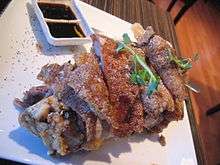
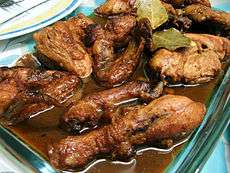

Adobo is one of the most popular Filipino dishes and is considered unofficially by many as the national dish. It usually consists of pork or chicken, sometimes both, stewed or braised in a sauce usually made from vinegar, cooking oil, garlic, bay leaf, peppercorns, and soy sauce. It can also be prepared "dry" by cooking out the liquid and concentrating the flavor. Bistek, also known as "Filipino beef steak," consists of thinly sliced beef marinated in soy sauce and calamansi and then fried in a skillet that is typically served with onions.
Some well-known stews are kare-kare and dinuguan. In kare-kare, also known as "peanut stew", oxtail or ox tripe is the main ingredient and is cooked with vegetables in a peanut-based preparation. It is typically served with bagoong (fermented shrimp paste). In dinuguan, pig's blood, entrails, and meat are cooked with vinegar and seasoned with chili peppers, usually siling mahaba.
Paksiw refers to different vinegar-based stews that differ greatly from one another based on the type of meat used. Paksiw na isda uses fish and usually includes the addition of ginger, fish sauce, and maybe siling mahaba and vegetables. Paksiw na baboy is a paksiw using pork, usually pork hocks, and often sees the addition of sugar, banana blossoms, and water so that the meat is stewed in a sweet sauce. A similar Visayan dish called humba adds fermented black beans. Both dishes are probably related to pata tim which is of Chinese origin. Paksiw na lechon is made from lechon meat and features the addition of ground liver or liver spread. This adds flavor and thickens the sauce so that it starts to caramelize around the meat by the time dish is finished cooking. Although some versions of paksiw dishes are made using the same basic ingredients as adobo, they are prepared differently, with other ingredients added and the proportions of ingredients and water being different.
In crispy pata, pork knuckles (the pata) are marinated in garlic-flavored vinegar then deep fried until crisp and golden brown, with other parts of the pork leg prepared in the same way. Lechon manok is the Filipino take on rotisserie chicken. Available in many hole-in-the-wall stands or restaurant chains (e.g. Andok's, Baliwag, Toto's, Sr. Pedro's, G.S. Pagtakhan's), it is typically a specially seasoned chicken roasted over a charcoal flame served with "sarsa" or lechon sauce made from mashed pork liver, starch, sugar, and spices.
Mechado, kaldereta, and afritada are Spanish influenced tomato sauce-based dishes that are somewhat similar to one another. In these dishes meat is cooked in tomato sauce, minced garlic, and onions. Mechado gets its name from the pork fat that is inserted in a slab of beef making it look like a wick (mitsa) coming out of a beef "candle". The larded meat is then cooked in a seasoned tomato sauce and later sliced and served with the sauce it was cooked in. Kaldereta can be beef but is also associated with goat. Chunks of meat are cooked in tomato sauce, minced garlic, chopped onions, peas, carrots, bell peppers and potatoes to make a stew with some recipes calling for the addition of soy sauce, fish sauce, vinegar, chilies, ground liver or some combination thereof. Afritada tends to be the name given to the dish when chicken and pork is used. Another similar dish said to originate from the Rizal area is waknatoy. Pork or beef sirloin is combined with potatoes and cut sausages and cooked in a tomato-based sauce sweetened with pickles. Puchero is derived from the Spanish cocido; it is a sweeter stew that has beef and banana or plantain slices simmered in tomato sauce.
Filipinos also eat tocino and longganisa. Tocino is a sweetened cured meat made with either chicken or pork and is marinated and cured for a number of days before being fried. Longganisa is a sweet or spicy sausage, typically made from pork though other meats can also be used, and are often colored red traditionally through the use of the anatto seed but also artificial food coloring.
.jpg)
Filipino soups tend to be very hearty and stew-like containing large chunks of meat and vegetables or noodles. They are usually intended to be filling and not meant to be a light preparatory introduction for the main course. They tend to be served with the rest of the meal and eaten with rice when they are not meals unto themselves. They are often referred to on local menus under the heading sabaw (broth). Sinigang is a popular dish in this category distinguished by its sourness that often vies with adobo for consideration as the national dish. It is typically made with either pork, beef, chicken or seafood and made sour with tamarind or other suitable souring ingredients. Some seafood variants for example can be made sour by the use of guava fruit or miso. Another dish is tinola. It has large chicken pieces and green papaya/sayote slices cooked with chili, spinach, and moringa leaves in a ginger-flavored broth. Nilagang baka is a beef stew made with cabbages and other vegetables. Binacol is a warm chicken soup cooked with coconut water and served with strips of coconut meat. La Paz batchoy is a noodle soup garnished with pork innards, crushed pork cracklings, chopped vegetables, and topped with a raw egg. Another dish with the same name uses misua, beef heart, kidneys and intestines, but does not contain eggs or vegetables. Mami is a noodle soup made from chicken, beef, pork, wonton dumplings, or intestines (called laman-loob). Ma Mon Luk was known for it. Another chicken noodle soup is sotanghon, consisting of cellophane noodles[25] (also called sotanghon and from whence the name of the dish is derived), chicken, and sometimes mushrooms.
Noodle dishes are generally called pancit. Pancit recipes primarily consist of noodles, vegetables, and slices of meat or shrimp with variations often distinguished by the type of noodles used. Some pancit, such as mami and La Paz-styled batchoy, are noodle soups while the "dry" varieties are comparable to chow mein in preparation. Then there is spaghetti or ispageti in the local parlance that is a modified version of spaghetti bolognese. It is sometimes made with banana ketchup instead of tomato sauce, sweetened with sugar and topped with hot dog slices.
There are several rice porridges that are popular in the Philippines. One is arroz caldo which is a rice porridge cooked with chicken, ginger and sometimes saffron, garnished with spring onions (chives), toasted garlic, and coconut milk to make a type of gruel. Another variant is goto which is an arroz caldo made with ox tripe. There is also another much different rice porridge called champorado which is sweet and flavored with chocolate and often served at breakfast paired with tuyo or daing.
Another rice-based dish is arroz a la valenciana,[26] a Spanish paella named after the Spanish region Valencia that has been incorporated into the local cuisine. Bringhe is a local rice dish with some similarities to paella but using glutinous rice, coconut milk, and turmeric. Kiampong a type of fried rice topped with pork pieces, chives and peanuts. It can be found in Chinese restaurants in Binondo and Manila. Camaron rebosado con jamon has been described as a classic dish in the Binondo district of Manila, the city's Chinatown.[27]
For vegetarians, there is dinengdeng, a dish consisting of moringa leaves (malunggay) and slices of bittermelon. There is also pinakbet, stewed vegetables heavily flavored with bagoong. A type of seafood salad known as kinilaw is made up of raw seafood such as fish or shrimp cooked only by steeping in local vinegar, sometimes with coconut milk, onions, spices and other local ingredients. It is comparable to the Peruvian ceviche.
Side dishes and complements
Itlog na pula (red eggs) are duck eggs that have been cured in brine or a mixture of clay-and-salt for a few weeks, making them salty. They are later hard boiled and dyed with red food coloring (hence the name) to distinguish them from chicken eggs before they are sold over the shelves. They are often served mixed in with diced tomatoes. Atchara is a side dish of pickled papaya strips similar to sauerkraut. It's a frequent accompaniment to fried dishes like tapa or daing.
Nata de coco is a chewy, translucent, jelly-like food product produced by the fermentation of coconut water[28] can be served with pandesal. Kesong puti is a soft white cheese made from carabao milk (although cow milk is also used in most commercial variants). Grated mature coconut (niyog), is normally served with sweet rice-based desserts.
Desserts
As the Philippines is a tropical country, it should come as no surprise that there are many treats made from rice and coconuts. One often seen dessert is bibingka, a hot rice cake optionally topped with a pat of butter, slices of kesong puti (white cheese), itlog na maalat (salted duck eggs), and sometimes grated coconut. There are also glutinous rice sweets called biko made with sugar, butter, and coconut milk. In addition, there is a dessert known as bitsu-bitsu, also known as a Pinoy donut, made with fried rice flour which is then coated with Muscovado sugar syrup. There is also Karioka, made from glutinous rice flour, coconut, and coconut milk, fried and skewered and slathered with a brown sugar glaze. Another brown rice cake is kutsinta. Puto is another well-known example of sweet steamed rice cakes prepared in many different sizes and colors. Sapin-sapin (sapin means layer) are three-layered, tri-colored sweets made with rice flour, purple yam, and coconut milk characterized by its gelatinous appearance. Palitaw are rice patties that are covered with sesame seeds, sugar, and coconut; pitsi-pitsi which are cassava patties coated with cheese or coconut; and tibok-tibok is based on carabao milk as a de leche (similar to maja blanca). As a snack, binatog is created with corn kernels with shredded coconut. Packaged snacks wrapped in banana or palm leaves then steamed, suman are made from sticky rice. For cold desserts there is halo-halo which can be described as a dessert made with shaved ice, milk, and sugar with additional ingredients like coconut, halaya (mashed purple yam), "leche flan" or caramel custard, plantains, jackfruit, red beans, tapioca and pinipig being typical. Other similar treats made with shaved ice include saba con yelo which is shaved ice served with milk and minatamis na saging (ripe plantains chopped and caramelized with brown sugar); mais con yelo which is shaved ice served with steamed corn kernels, sugar, and milk; and buko pandan sweetened grated strips of coconut with gulaman, milk, and the juice or extract from pandan leaves. Sorbetes (ice cream) is popular, as well, with some local versions utilizing coconut milk instead of cow milk. Ice candy, are popular frozen snacks usually made from fruit juice, chocolate or local ingredients such as mung beans and ube. It can be any kind of flavor depending on the maker; chocolate and buko (coconut) flavored ice candy are two of the most popular. Another dessert, often served during Christmas and New Year's Eve, is Mango float,[29] a dessert composed of Graham cracker, mangoes, cream and milk, and created by layering them together in a dish and then refrigerating or blast chilling.
Street food and other snacks

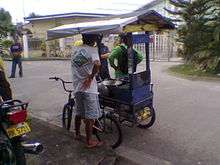
Aside from pastries and desserts, there are heartier snacks for merienda that can also serve as either an appetizer or side dish for a meal. Siomai is the local version of Chinese shaomai. Lumpia are spring rolls that can be either fresh or fried. Fresh lumpia (lumpiang sariwa) is usually made for fiestas or special occasions as it can be labor-intensive to prepare, while one version of fried lumpia (lumpiang prito), lumpiang shanghai is usually filled with ground pork and a combination of vegetables, and served with a sweet and sour dipping sauce.[30] Other variations are filled with minced pork and shrimp and accompanied by a vinegar-based dipping sauce. Lumpia has been commercialized in frozen food form.
There's a distinct range of street foods available in the Philippines. Some of these are skewered on sticks in the manner of a kebab. One such example is banana-cue which is a whole banana or plantain skewered on a short thin bamboo stick, rolled in brown sugar, and pan-fried. Kamote-cue is a peeled sweet potato skewered on a stick, covered in brown sugar and then pan-fried. Fish balls or squid balls are also pan-fried, then skewered on bamboo sticks and given to the customer, who then has a choice of dipping in a sweet or savory sauce. These are commonly sold frozen in markets and peddled by street vendors.
Turon, a kind of lumpia consisting of an eggroll or phyllo wrapper commonly filled with sliced plantain and occasionally jackfruit, is fried and sprinkled with sugar.
Taho is a warm treat made of soft beancurd which is the taho itself, dark caramel syrup called arnibal, and tapioca pearls. It is often sold in neighborhoods by street vendors who yell out "taho" in a manner comparative to vendors in the stands at sporting events yelling out "hotdogs" or "peanuts". Sometimes, taho is served chilled, and flavors have recently been added, such as chocolate or strawberry. Taho is derived from the original Chinese snack food known as douhua.
There is also iskrambol (from the English "to scramble"), a kind of iced-based treat similar to a sorbet. The shaved ice is combined with various flavorings and usually topped with chocolate syrup. It is eaten by "scrambling" the contents or mixing them, then drinking with a large straw. It was later modified into ice scramble, or simply scramble, but with added skim milk, chocolate and/or strawberry syrup, and a choice of toppings such as marshmallows, chocolate or candy sprinkles, rice crispies, or tapioca pearls.
Street food featuring eggs include kwek-kwek which are hard-boiled quail eggs dipped in orange-dyed batter and then deep fried similar to tempura. Tokneneng is a larger version of kwek-kwek using chicken or duck eggs. Another Filipino egg snack is balut, essentially a boiled pre-hatched poultry egg, usually duck or chicken. These fertilized eggs are allowed to develop until the embryo reaches a pre-determined size and are then boiled. There is also another egg item called penoy, which is basically hard-boiled unfertilized duck eggs, but does not contain the embryo. Like taho, balut is advertised by street hawkers calling out their product.
Okoy, also spelled as ukoy, is another batter-covered, deep-fried street food in the Philippines. Along with the batter, it normally includes bean sprouts, shredded pumpkin and very small shrimps, shells and all. It is commonly dipped in a combination of vinegar and chilli.
Among other street food are already mentioned pulutan like isaw, seasoned hog or chicken intestines skewered onto a stick and grilled; betamax, roasted dried chicken blood cut into and served as small cubes, from which it received its name due to a resemblance to a Betamax tape; Adidas, grilled chicken feet named after the popular shoe brand; and proven, the proventriculus of a chicken coated in cornstarch and deep-fried. Fries made from sweet potatoes have also been dubbed "Pinoy fries".
Exotic dishes
Some exotic dishes in the Filipino diet are camaro, which are field crickets cooked in soy sauce, salt, and vinegar, and is popular in Pampanga; papaitan, which is a stew made of goat or beef innards flavored with bile that gives it its characteristic bitter (pait) taste; Soup No. 5 (Also spelled as "Soup #5") which is a soup made out of bull's testes,[31][32] and can be found in restaurants in Ongpin St., Binondo, Manila; and pinikpikan na manok that involves having a chicken beaten to death to tenderize the meat and to infuse it with blood. It is then burned in fire to remove its feathers then boiled with salt and itag (salt/smoke cured pork).[33][34] The act of beating the chicken in preparation of the dish violates the Philippine Animal Welfare Act 1998.[35]
Cooking methods
The Filipino/Tagalog words for popular cooking methods and terms are listed below:
- "Adobo/Inadobo" − cooked in vinegar, oil, garlic and soy sauce.
- "Babad/Binabad/Ibinabad" − to marinate.
- "Banli/Binanlian/Pabanli" − to blanch.
- "Bagoong/Binagoongan/ – sa Bagoong" − cooked with fermented fish/shrimp paste bagoong.
- "Binalot" – literally "wrapped." This generally refers to dishes wrapped in banana leaves, pandan leaves, or even aluminum foil. The wrapper is generally inedible (in contrast to lumpia — see below).
- "Buro/Binuro" − fermented.
- "Daing/Dinaing/Padaing" − marinated with garlic, vinegar, and black peppers. Sometimes dried and usually fried before eating.
- "Guinataan/sa Gata" − cooked with coconut milk.
- "Guisa/Guisado/Ginisa" or "Gisado" − sautéed with garlic, onions and/or tomatoes.
- "Halabos/Hinalabos" – mostly for shellfish. Steamed in their own juices and sometimes carbonated soda.
- "Hilaw/Sariwa" – unripe (for fruits and vegetables), raw (for meats). Also used for uncooked food in general (as in lumpiang sariwa).
- "Hinurno" – baked in an oven or roasted.
- "Ihaw/Inihaw" − grilled over coals.
- "Kinilaw" or "Kilawin" − fish or seafood marinated in vinegar or calamansi juice along with garlic, onions, ginger, tomato, peppers.
- "Laga/Nilaga/Palaga" − boiled/braised.
- "Nilasing" − cooked with an alcoholic beverage like wine or beer.
- "Lechon/Litson/Nilechon" − roasted on a spit.
- "Lumpia" – savory food wrapped with an edible wrapper.
- "Minatamis" − sweetened.
- "Pinakbet" − to cook with vegetables usually with sitaw (yardlong beans), calabaza, talong (eggplant), and ampalaya (bitter melon) among others and bagoong.
- "Paksiw/Pinaksiw" − cooked in vinegar.
- "Pangat/Pinangat" − boiled in salted water with fruit such as tomatoes or ripe mangoes.
- "Palaman/Pinalaman" − "filled" as in siopao, though "palaman" also refers to the filling in a sandwich.
- "Pinakuluan" – boiled.
- "Prito/Pinirito" − fried or deep fried. From the Spanish frito.
- "Relleno/Relyeno" – stuffed.
- "Tapa/Tinapa" – dried and smoked. Tapa refers to meat treated in this manner, mostly marinated and then dried and fried afterwards. Tinapa meanwhile is almost exclusively associated with smoked fish.
- "Sarza/Sarciado" – cooked with a thick sauce.
- "Sinangag" – garlic fried rice.
- "Sigang/Sinigang" − boiled in a sour broth usually with a tamarind base. Other common souring agents include guava, raw mangoes, calamansi also known as calamondin.
- "Tosta/Tinosta/Tostado" – toasted.
- "Torta/Tinorta/Patorta" – to cook with eggs in the manner of an omelette.
- "Turon/Turrones" - wrapped with an edible wrapper; dessert counterpart of lumpia.
Native ingredients
Philippine cuisine has a variety of native ingredients used. The biota that developed yielded a particular landscape and in turn gave the place local ingredients that enhanced flavors to the dishes. Kalamansi is the more known of those ingredients, it is a fruit that belongs to the genus citrus. It is mostly used due to the sourness it gives to a dish.[36] Another is the Tabon-tabon, a tropical fruit which were used by pre-colonial Filipinos as anti-bacterial ingredient especially in Kinilaw dishes.[37] The country also cultivates different type of nuts and one of them is the Pili nut, which the Philippines is the only known edible exporter of. It is usually made as a merienda or is incorporated in other desserts to enhance the flavor due to the milky texture it gives off as it melts in the mouth.[38] Tultul, a type of rock salt is another ingredient made only in Guimaras whom most use it to sprinkle on cooked rice to serve as a viand. The salt is an assortment of reeds, twigs and small pieces of bamboo carried to the shore by the sea tide where they have been soaked in seawater for some time and is then burned in large quantities while continually being doused with salt water on a daily basis. The ashes then is strained continuously by kaings and are then cooked in pans.[39] In Visayas, another souring agent in dishes in the form of Batuan (Garcinia binucao) is used. It is a fruit that is greenish, yellowish, somewhat rounded, and four centimeters or more in diameter. They have a firm outer covering and contain a very acid pulp and several seeds.[40]
Beverages
Chilled drinks and shakes
_at_Imay's.jpg)
Chilled drinks are popular due to the tropical climate. Stands selling cold fruit drinks and fruit shakes are common in many of the city areas, where some are based on green mandarin orange (dalandan or dalanghita), pomelo (suha), pineapple (pinya), banana (saging), and soursop (guyabano). The shakes usually contain crushed ice, evaporated or condensed milk, and fruits like the perennially popular mango. Other fruit flavors are melon, papaya, avocado, watermelon, strawberry, and durian to name a few.
Other chilled drinks include sago't gulaman, a flavored ice drink of pre-Hispanic Malay origin (Malay: gula melaka) with sago and agar gelatin with banana extract sometimes added to the accompanying syrup; fresh buko or coconut juice, the water or juice straight out of a young coconut via an inserted straw, a less fresh variation of which is from bottled coconut juice, scraped coconut flesh, sugar, and water; and kalamansi juice, the juice of kalamansi or Philippine limes usually sweetened with honey, syrup or sugar.
Brewed beverages
The Philippines is a predominantly coffee-drinking country. One of the most popular variants of coffee coming from the mountains of Batangas is known as kapeng barako. Another well-known variant of coffee is the civet coffee. It is called kape motit in the Cordilleras, kape alamid in Tagalog region, and kape musang in Mindanao. The Kalinga coffee known for its organic production is also rapidly gaining popularity. Highlands coffee, or Benguet coffee, is a blend of Robusta and Excelsa beans.[41]
Even before the establishment of coffeehouses in the Philippines, coffee has been part of the Filipino meal. Carinderias would often serve them along with meals. The opening of Starbucks in 1997 paved the way for other coffee shops.[42]
Tea consumption in the Philippines is driven primarily by growing health consciousness amongst middle- to high-income consumers.[43] Tea is commonly prepared using Philippine wild tea or tea tree.[44] There are several known variations of tea using different additives. Pandan iced tea is one of these, made with pandan leaves and lemongrass. Salabat, sometimes called ginger tea, is brewed from ginger root and usually served during the cold months, and when illnesses such as a sore throat strikes.
Late 2010 saw the opening of tea shops around the metro, and with a glass of milk tea being more affordable than the usual cold designer coffee, it paved the way into making tea a food trend. Among the top players in the Philippine tea scene are ShareTea, Happy Lemon, Chatime, Serenitea and Moonleaf Tea Shop.[45]
Tsokolate is the Filipino take on hot chocolate. It is traditionally made with tablea, which are pure cacao beans that are dried, roasted, ground and then formed into tablets.[46]
Alcoholic beverages

There are a wide variety of alcoholic drinks in the Philippines manufactured by local breweries and distilleries.
Beer or serbesa (from the Spanish "cerveza") is the most preferred alcoholic drink in the Philippines. San Miguel Pale Pilsen is the most popular and most widely known brand, with Beer na Beer coming in a close second. San Mig Light is preferred mostly by yuppies and young drinkers. Gold Eagle Beer is more common in the rural areas of the Philippines. Colt 45 and Red Horse Beer, with their higher alcohol content, are brands favored by hard drinkers. Other beer labels include Lone Star, Lone Star Light, Lone Star Ultra, Carlsberg, Coors Light, San Miguel Superdry, San Mig Strong Ice, and just recently, Manila Beer. Several bars in the urban areas also serve international brands.
Rum is often associated with Tanduay.
Several gins, both local varieties like Ginebra San Miguel (as well as GSM Blue and GSM Premium Gin) and imported brands like Gilbey's, are commonly found. Some people refer to gin by the shape of the bottle: bilog for a circular bottle and kwatro kantos (literally meaning four corners) for a square or rectangular bottle. Gin is sometimes combined with other ingredients to come up with variations.
Tuba (toddy) is a type of hard liquor made from fresh drippings extracted from a cut young stem of palm. The cutting of the palm stem usually done early in the morning by a mananguete, a person who climbs palm trees and extracts the tuba to supply to customers later in the day. The morning's accumulated palm juice or drippings are then harvested by noon, and brought to buyers then prepared for consumption. Sometimes this is done twice a day so that there are two harvests of tuba occurring first at noon-time and then in the late-afternoon. Normally, tuba has to be consumed right after the mananguete brings it over, or it becomes too sour to be consumed as a drink. Any remaining unconsumed tuba is then often stored in jars to ferment for several days and become palm vinegar. Tuba can be distilled to produce lambanog (arrack), a neutral liquor often noted for its relatively high alcohol content.
Lambanog is an alcoholic beverage commonly described as coconut wine or coconut vodka. The drink is distilled from the sap of the unopened coconut flower, and is known for its potency and high alcohol content (80 and 90 proof). Most of the Lambanog distilleries are in the Quezon province of Luzon, Philippines. Constant efforts at standardizing lambanog production has led to its better quality. Presently, lambanog is being exported to other countries and continues to win foreign customers over due to its natural ingredients as well as its potency.
Tapuy is a traditional Philippine alcoholic drink made from fermented glutinous rice. It is a clear wine of luxurious alcoholic taste, moderate sweetness and lingering finish. Its average alcohol content is 14% or 28 proof, and it does not contain any preservatives or sugar. To increase the awareness of tapuy, the Philippine Rice Research Institute has created a cookbook containing recipes and cocktails from famous Philippine chefs and bartenders, featuring tapuy as one of the ingredients.
Eating methods
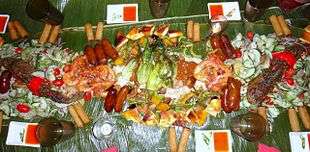
During the Spanish occupation, which yielded Western influences, Filipinos ate with the paired utensils of spoon and fork. The knife, although present, was not widely used as in other countries.[47]
Nowadays, the use of hands during eating, known as "kamayan" (using the washed left hand for picking the centralized food and the right hand for bringing food to the mouth), has become a trend. Kamayan generally means "eating with your hands", which was how Filipinos ate before the colonization of the country. It is further becoming more popular due to the incorporation of the "boodle fight" concept, a style of dining popularized by the Philippine Army, which utilizes banana leaves spread out on the table as the main serving platter, upon which is laid out portions of rice and a variety of Filipino viand for brotherly, friendly, filial, or communal feasting. The use of spoons and forks, however, is still the norm.
See also
References
- ↑ Alejandro, Reynaldo (1985). The Philippine cookbook. New York, New York: Penguin. pp. 12–14. ISBN 978-0-399-51144-8. Retrieved 30 June 2011.
Civitello, Linda (2011). Cuisine and Culture: A History of Food and People. John Wiley and Sons. p. 263. ISBN 978-1-118-09875-2. Retrieved 30 June 2011.Just as Filipino people are part Malay, Chinese and Spanish, so is the cuisine of their seven-thousand-island nation
Philippines Country Study Guide. Int'l Business Publications. 2007. p. 111. ISBN 978-1-4330-3970-6. Retrieved 30 June 2011.Throughout the centuries, the islands have incorporated the cuisine of the early Malay settlers, Arab and Chinese traders, and Spanish and American colonizers along with other Oriental and Occidental accent and flavors.
"Philippine Cuisine." Balitapinoy.net. Accessed July 2011.
Morgolis, Jason (6 February 2014). "Why is it so hard to find a good Filipino restaurant?". Public Radio International. Retrieved 17 December 2014.Philippine food has Chinese, Malaysian, Spanish and American influences — all cultures that have shaped the Philippines.
- 1 2 3 "CNN poll: Philippines has world's 2nd best food". The Philippine Star. June 16, 2015. Retrieved April 7, 2016.
- ↑ Knuuttila, Kyle. (c. 2006). Rice in the Philippines. Retrieved 2010-10-03 from the Center for Southeast Asian Studies, Northern Illinois University.
- 1 2 Wu, David Y.H.; Cheung, Sidney C.H. (2002), The globalization of Chinese food, Curzon
- ↑ Goyan Kittler, Pamela; Sucher, Kathryn (2007). Food and Culture. Cengage Learning. p. 384. Retrieved July 18, 2012.
- ↑ "Philippines – Eating Habits & Hospitality". The Global Gourmet. Retrieved 2006-11-21.
- ↑ "Rice in the Philippines". International Rice Research Institute.
- ↑ "Pakaplog". Pinoy Slang. Retrieved 2008-11-12.
- ↑ Francia, L. (1997). Passport Philippines: Your Pocket Guide to Filipino Business, Customs & Etiquette. Passport to the world. World Trade Press. p. 86. ISBN 978-1-885073-40-2.
- ↑ Davidson, A.; Jaine, T. (2014). The Oxford Companion to Food. Oxford Companions. OUP Oxford. p. 514. ISBN 978-0-19-104072-6.
- ↑ "Philippines: Bizarre Foods with Andrew Zimmern". Retrieved 2007-07-16.
- ↑ Vicky B. Bartlet (17 December 2011). "Palmonas: Make 'buko' juice as national drink". Business Mirror. Retrieved 26 January 2012.
- ↑ Abby. "Lumpiang Shanghai (Filipino Spring Rolls)". Manila Spoon.
- ↑ "100% Pinoy: Pinoy Panghimagas". (2008-07-04). [Online video clip.] GMA News. Retrieved 2009-12-13.
- ↑ "Bicol Native Cuisine". Camarines Sur Provincial Government.
- ↑ "Foods You Shouldn't Miss When Visiting Bacolod". Islands of the Philippines. Retrieved 26 June 2013.
- ↑ "Adventurous in Aklan: A 'Biyahe ni Drew' itinerary". GMA News Online. Retrieved 7 April 2016.
- ↑ ""Tamilok" (shipworm) now a tourism lure in Aklan". balita.ph - Online Filipino News. Retrieved 7 April 2016.
- ↑ "Ateneo Students Go Food Tripping in Kalibo". Ateneo de Manila University. Retrieved 7 April 2016.
- ↑ Diaz, Anton. "Ilo-ilo Food Trip". Our Awesome Planet. Retrieved 27 June 2013.
- ↑ ABS-CBN Corp. "A Big Warm Bowl of Flavorful Molo". Choose Philippines. Retrieved 7 April 2016.
- ↑ "FLAVOURS OF ILOILO and beyond ...: KBL - Kadyos, Baboy, Langka". Retrieved 7 April 2016.
- ↑ "FLAVOURS OF ILOILO and beyond ...: Kadyos, manok kag ubad". Retrieved 7 April 2016.
- ↑ Bureau of Agricultural Research Chronicle
- ↑ Alejandro, R.G.; Tettoni, L.I. (2015). Food of the Philippines. Periplus Editions. p. 53. ISBN 978-1-4629-0545-4.
- ↑ Ku, R.J.S. (2013). Eating Asian America: A Food Studies Reader. NYU Press. p. 150. ISBN 978-1-4798-1023-9.
- ↑ Perez, Irene C. (February 16, 2012). "Camaron Rebosado con Jamon and other 'mestizong Intsik' favorites". Philippine Daily Inquirer. Retrieved April 7, 2016.
- ↑ Sanchez, P.C. (2008). Philippine Fermented Foods: Principles and Technology. University of the Philippines Press. p. 378. ISBN 978-971-542-554-4.
- ↑ Elizabeth Ann Quirino (16 December 2014). "Have Filipino food, will travel". Philippine Daily Inquirer. Retrieved 21 December 2014.
- ↑ Besa, Amy & Romy Dorotan. (2006). Memories of Philippine Kitchens. Stewart, Tabori & Chang. ISBN 1-58479-451-8.
- ↑ "Bizarre food with Andrew Zimmern – Philippines". Retrieved 2007-07-16.
- ↑ Sutherland, Matthew. (2000-02-06). "All a matter of taste". The Filipino Express. Retrieved 2010-10-03 from www.tingog.com.
- ↑ Fenix, Mickey. (2006-06-07). "Ringside view of pinikpikan process". The Philippine Daily Inquirer. Retrieved 2009-12-14.
- ↑ Johnson, Jody. (2006-05-28). "Killing me softly". [Weblog Entry.] Jody's Peace Corp Experience. Retrieved 2009-12-13.
- ↑ Republic of the Philippines. "The Animal Welfare Act 1998". Retrieved 2006-12-04.
In all the above mentioned cases, including those of cattle, pigs, goats, sheep, poultry, rabbits, carabaos, horses, deer and crocodiles the killing of the animals shall be done through humane procedures at all times.
- ↑ http://www.ititropicals.com/calamansi-fruit-fact-tidbits
- ↑ "History of Kinilaw". Retrieved 7 April 2016.
- ↑ "What are Pili Nuts?". Pili Nuts. Retrieved 7 April 2016.
- ↑ http://themeltedice-manggahan.blogspot.com/2008/05/tultul-production.html
- ↑ "For resource id Ilonggo's "batuan" fruit undergoes DNA barcoding". philstar.com. Retrieved 7 April 2016.
- ↑ "Garcia's Pure Coffee". Garcia's Kape, Tinapay Atbp. Retrieved March 21, 2013.
- ↑ "Starbucks in the Philippines".
- ↑ "Tea in the Philippines". euromonitor.com.
- ↑ "Philippine Medicinal Plants - Tsaang Gubat". www.stuartexchange.com.
- ↑ Consunji, Bianca. "The Mad Tea Party". Inquirer.
- ↑ "Tablea Chocolate Cafe".
- ↑ http://askthepinoy.blogspot.com/2011/01/why-do-filipinos-eat-with-spoon-and.html[]
Further reading
- Alcuaz, N.T. (2005). Banana Leaves: Filipino Cooking and Much More. Victoria: Trafford. ISBN 1-4120-5378-1. Retrieved 2009-12-12.
- Alejandro, Reynaldo. (1985). The Philippine Cookbook. New York: Perigee Books. p. 13. ISBN 0-399-51144-X. Retrieved 2009-12-10.
- Aleson, Susana, Alice Gratil, Lota Ignacio, Mhila Baiyon, Gladys Moya, and Virginia Zarate. (1998). Cocina Filipina (in Spanish). Barcelona: Icaria. ISBN 84-7426-358-1. Retrieved 2009-12-12.
- Arroyo, Patricia T. (1974). The Science of Philippine food. Quezon City: Abaniko Enterprises.
- Barreto, Glenda R. (2007). Flavors of the Philippines – A Culinary Guide to the Best of the Islands. Manila: Anvil. ISBN 971-27-1869-7.
- Barreto, Glenda R., Conrad Calalang, Margarita Fores, Myrna Segismundo, Jessie Sincioco, and Claude Tayag. (2008). Kulinarya – A Guidebook to Philippine Cuisine (Michaela Fenix, Ed.). Manila: Asia Society. ISBN 971-27-2108-6.
- Bernardino, Minnie. (September 27, 1990). "Breakfast – 8 Places Off the Beaten-Egg Track – Ethnic fare: Breakfast is many things to many peoples, as L.A.'s restaurants prove. A sampling from the variety available to a.m. adventurers. – Filipino". Los Angeles Times.
- Bayhon-Yrastorza, Caren. (December 16, 2010). Recipe: Chicken relleno for Noche Buena. ABS-CBN News. Retrieved December 24, 2010.
- Classic, fail-safe 'Noche Buena' recipes. (December 24, 2009). ABS-CBN News. Retrieved December 24, 2010.
- Davidson, Alan and Tom Jaine. (2006). The Oxford Companion to Food (2nd ed.). New York: Oxford University Press. pp. 600–601. ISBN 0-19-280681-5.
- Davidson, Alan. (2003). Seafood of South-East Asia: A Comprehensive Guide with Recipes (2nd ed.). Ten Speed Press. pp. 279–295. ISBN 1-58008-452-4. Retrieved 2009-12-14.
- DuJunco, Mercedes. (2006). "Luzon, Philippines". In Sean Williams. The Ethnomusicologists' Cookbook: Complete Meals from Around the World. New York: Routledge. p. 85. ISBN 0-415-97818-1. Retrieved 2009-12-10.
- Fernandez, Doreen. (1988). "Culture Ingested: On the Indigenization of Philippine Food". In E.N. Alegre & D. G. Fernandez (Eds.) Sarap: Essays on Philippine Food. Manila: Mr. & Ms. Publishing Company, Inc. Retrieved 2010-08-02.
- Fernandez, Doreen. (2000). "What is Filipino Food?". In Reynaldo G. Alejandro. Food of the Philippines. Boston: Periplus Editions. p. 7. ISBN 962-593-245-3. Retrieved 2009-12-10.
- Gelle, Gerry G. (2008). Filipino Cuisine: Recipes from the Islands (3rd ed.). Museum of New Mexico Press. ISBN 0-89013-513-4.
- Halili, Maria Christine N. (2004). Philippine History. Rex Bookstore. pp. 42–50. ISBN 971-23-3934-3. Retrieved 2011-02-02.
- International Business Publications, USA. (2008). Philippines Country Study Guide (4th ed.). Washington, D.C.: International Business Publications, USA. pp. 111–113. ISBN 1-4330-3970-2. Retrieved 2009-12-12.
- Nolan, James L. (1996). Philippines Business: The Portable Encyclopedia for Doing Business with the Philippines. San Rafael: World Trade Press. p. 143. ISBN 1-885073-08-9. Retrieved 2009-12-10.
- Orosa, Maria Y. and Helen Orosa del Rosario. (1970). Maria Y. Orosa, Her Life and Work (Helen Orosa del Rosario, Ed.). [Quezon City:] R. P. Garcia Pub. Co.
- Philippine Cuisine. (n.d.). Tagalog at NIU. Retrieved 2011-01-17 from the Northern Illinois University, Center for Southeast Asian Studies, SEAsite Project.
- Rodell, Paul A. (2002). Culture and Customs of the Philippines. Westport: Greenwood. p. 102. ISBN 0-313-30415-7. Retrieved 2009-12-10.
- Rowthorn, Chris & Greg Bloom. (2006). Philippines (9th ed.). Lonely Planet. p. 47. ISBN 1-74104-289-5. Retrieved 2009-12-10.
- Sokolov, Raymond. (1993). Why We Eat What We Eat – How Columbus Changed the Way the World Eats. Simon & Schuster. ISBN 0-671-79791-3.
- Solomon, Charmaine. (2002). The Complete Asian Cookbook (2nd ed.). Turtle Publishing. pp. 347–366. ISBN 0-8048-3757-0. Retrieved 2009-12-14.
- Sta. Maria; Felice Prudente. (2006). The Governor-General's Kitchen – Philippine Culinary Vignettes and Period Recipes – 1521–1935. Manila: Anvil. ISBN 971-27-1696-1.
- Zibart, Eve. (2001). The Ethnic Food Lover's Companion: Understanding the Cuisines of the World. Menasha Ridge Press. pp. 266–280. ISBN 0-89732-372-6. Retrieved 2009-12-14.
- Zibart, Eve. (2000-09-08). "Fare Minded – Sam's II: Philippine Soul Food". Washington Post. p. N.21. Retrieved 12 March 2010.
External links
| Wikimedia Commons has media related to Cuisine of the Philippines. |
- Philippine cuisine at DMOZ
- McGeown, Kate (12 September 2012). "Philippine chefs look to take national cuisine mainstream". BBC News. Retrieved 12 September 2012.

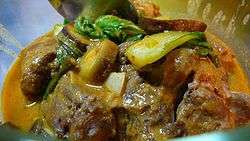

.jpg)
